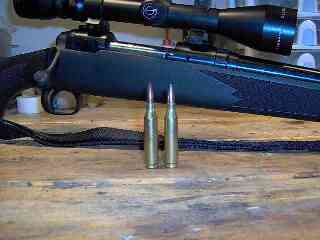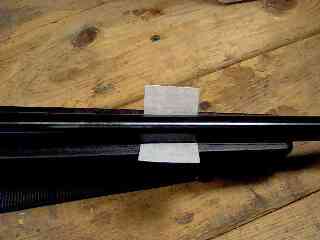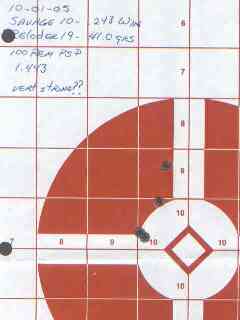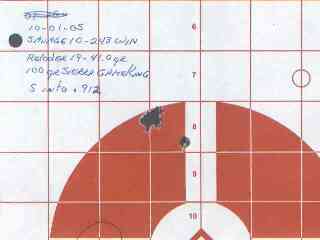|
Last June, I was shopping at Wal-Mart
The Savage Accutrigger is a great development in trigger design. It combines all the attributes that the casual rifleman demands in a trigger. It is safe, crisp, adjustable, and user friendly. My son has a Savage in 7mm Remington Mag, and he loves the Accutrigger. I shot it on a couple of occasions, and after getting familiar with it, came to see the benefits it had over a standard factory trigger. The Accutrigger may never replace aftermarket triggers like Timmey, or Basix but for the guy who wants a good trigger on a rifle he buys in a box, the Accutrigger is the best thing going. I like the Accutrigger and I can't see any reason to do anything at all to this trigger. It suits me fine and I am convinced it is the safest trigger I can use to teach my grandsons to shoot. I am also convinced that the Accutrigger is the biggest advance in factory firearms in the last fifty years. Superlatives fail when trying to describe the Accutrigger. The .243 Winchester cartridge was introduced by Winchester in 1955. The cartridge itself is widely credited to Warren Page, then the editor of Field and Stream magazine, who wildcatted the cartridge by necking down a .308 Winchester. The little 6mm cartridge was designed as a dual purpose, varmint and deer cartridge. Winchester picked it up and chambered it in their small action Model 70. It was destined to become one of the most successful cartridges of all time. I find it ironic that I haven't any experience with this cartridge, after fifty years as a successful commercial cartridge. Perhaps it was time for me to move into 20th century cartridge use.
Scopes today are a whole lot brighter, sharper, and more durable than when I was a youth. The Simmons scope on the rifle may be low-end, but it isn't cheap. It should be sturdy enough for years of use. The Savage Model 10 has a black finish. The finish doesn't look like blueing, having a darker tint. I would best describe it as a matte finish. The barrel comes without sights, and has a thin sporter taper. The rifle is a hunting rifle, through and through. It isn't particularly pretty, but it looks as if it can do the job day in and day out for years to come. All that was left was for me to shoot the rifle. I sent off to Midway USA for dies and started doing the research for powders and bullets. The .243 Winchester is a dual use cartridge, but I didn't want a varmint rifle. I wanted this rifle for the deer woods. I chose bullets in the 90-100 grain claass from Nosler, Speer, and Remington for testing. Looking through the various reloading manuals shows that the .243 Winchester works with a number of medium range rifle powders, from IMR 3031 and Hodgdon 414 for the smaller bullets, through the slower powders like Reloder 19 and IMR 4831 for the heavier bullets. I had both IMR 4831 and Reloder 19 on my bench, so I started with those powders for load development. The standard disclaimers about reloading should be reviewed here: Reloading and use of reloaded ammunition can be hazardous. Read up on safety procedures and seek competent instruction. Wear safety equipment such as eyeshield and gloves. The author assumes no liability for other persons who may use methods or data in this article. The Frugal Outdoorsman assumes no liability for persons who may use methods or data in this article. We are all adults here, and are expected to know the dangers inherent in our hobby. If you are a minor, please talk with a responsible adult before enjoying the hobby of reloading. I've liked the Nosler Ballistic Tip for accuracy. That bullet works extremely well in my son's 7mm Mag, turning in MOA accuracy when he does his part. I had a batch of new Remington cases and a brick of Winchester Large Rifle Primers. So, I worked up some loads with both Reloder 19 and IMR 4831 using the 95 grain Nosler bullet. The results are in the table below. Again, all cases are Remington and all primers are Winchester Large Rifle.
There are some interesting things in this table, but MOA groups aren't one of them. I noticed some vertical stringing in the 41 grain Rel 19 load. That particular group was only a half-inch wide, but walked up the paper. Some of the other groups showed the same propensity. Evidently that skinny barrel was less forgiving of heat than the heavy barrel 7mm Mag that my son shoots. But, lets look at the table. Notice the average velocities of the loads using Reloder 19 powder. The 38.0 grain load gave us a base velocity. An additional grain of powder gave us an additional 22 fps. Stepping up to 40 grains of powder gave an additional 29 fps. But, stepping up to 41.0 grs of Reloder 19 gave us a whopping 101 additional fps of velocity. There is something magical in that extra grain of powder and I believe it has to do with the efficency of the load. I increased the load an additional grain, and got about 20 fps, but the load exhibited signs of pressure. The primers started to flatten. So, with 41.0 grains of Reloder 19, I got a load with good velocity, with good accuracy and no troubling signs of pressure. I'm not quite up to the maximum load listed for this bullet combination., but this is the maximum load for my rifle. Adding that additional grain of powder showed indications for pressure. As in all reloading, this data is only good for my rifle and this particular powder/bullet combination. The IMR powder showed some potential at 41.8 grains. Vertical stringing was evident again, but the horizontal dimension of that group was small too, under half an inch. Evidently, some more testing was in order. My next task was to load the Nosler Ballistic Tip, the Sierra GameKing and the Remington PSP bullets over loads of 41 grains of Rel 19 and 41.8 grains of IMR 4831. The results are below. All cases are Remington new, and all primers are Winchester Large Rifle.
| ||||||||||||||||||||||||||||||||||||||||||||||||||||||||||||||||||||||||||||||||||||||||||||||||||||||||||||||||||


 The table only tells part of the story, so we have to look at some targets to get an idea of what the table represents. Over on the right is a target I shot with using 41.0 grs of Reloder 19 and the 100 grain Remington PSP bullet. This was the least expensive bullet used in the evaluation. Remington makes them by the truck load.
The table only tells part of the story, so we have to look at some targets to get an idea of what the table represents. Over on the right is a target I shot with using 41.0 grs of Reloder 19 and the 100 grain Remington PSP bullet. This was the least expensive bullet used in the evaluation. Remington makes them by the truck load. 